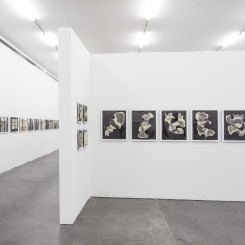GSD: Given contemporary Chinese art’s historical indebtedness to the prior example of Western modernism and postmodernism, it is, of course, possible to interpret Geng’s uncompromising resistance to authoritative meaning as a supplement to the comparably problematic activities of the Western avant-gardes and post avant-gardes. But we should also acknowledge a relationship with the persistent traces of traditional Chinese thought and practice. Consider, for example, Geng’s stated interest in the use of paradoxical epigrams (gong’an, or koan in Japanese) historically associated with Chan (Zen) Buddhism as a source of illumination.
PG: That old cliché — an alignment between deconstruction and Chan/Zen Buddhism. Historically, non-rationalist dialectical thinking has been used within China as a way of suggesting the possibility of harmonious reciprocation between otherwise opposed states of being as part of some higher metaphysical state of unity or consciousness. In contrast, the ostensibly comparable deconstructive conception of différance is understood to point towards the fundamental instability of categorical meanings both in terms of conceptual difference and totality.
GSD: It could, of course, be argued that the historical and still-durable tendency towards non-rationalist metaphysics within Chinese cultural contexts is very much open to problematization through close deconstructive analysis. However, as Geng’s video installation “The Direction of Vision” indicates, to do so would require an inescapably problematic imposition of historically located Westernized cultural values. What remains, therefore, is a seemingly unresolvable impasse: one in which we are forced to shuttle endlessly between one interpretative perspective — that sees non-rationalist dialectical thought as fundamentally deconstructive — and another that sees it as the basis for some sort of cosmic unity.
PG: At the same time, it is possible to argue with reference to Jacques Derrida’s radical collage-text “Glas” that this juxtaposition of apparently opposed cultural perspectives also holds out the prospect of a critical polylogue of Western and Chinese cultural meanings and values — one that opens up those identities to one another while internally dividing and questioning the authority of both. In following this line of argument, it is no longer possible to interpret Geng’s work convincingly from the point of view of some sort of synthetic alignment between existing Western and Chinese theoretical/practical models, or, for that matter, in an ontologically essentialist manner from the point of view of one or the other. Instead, Geng’s work emerges as the locus for a dynamic, non-essential interpretative interaction between multiple, already hybrid, cultural points of view that, among other things, insists on the capacity of a non-rationalistic dialectics to point both towards provisional states of reciprocity and persistent states of difference.
GSD: In acknowledging this dynamic state of interaction it will also have become necessary to diverge, despite their ostensible appropriateness, from an uncritical stance toward the currently fashionable conceptions of cultural hybridity and “Third-Space,” since the undeniable allegiances of those conceptions to Western(ized) post-structuralism are in the “final analysis” just too culturally loaded to map securely onto the rather less certain intersection of cultural traces that mark Geng’s work….
PG: I see you’ve already given this some thought.
GSD: Well, whatever the theoretical prognosis, Geng’s show is a cut above the Biennale in my view. It demonstrates, for those with the patience to see, that there is the possibility of a critical art in China: one that avoids recuperation by being persistently oblique.
Gladston looks out of the window into the quad. Hordes of students stream through. The light begins to diminish.
